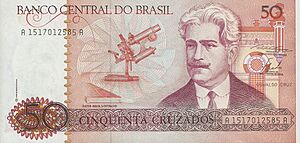Oswaldo Cruz facts for kids
Quick facts for kids
Oswaldo Cruz
|
|
|---|---|
 |
|
| Born |
Oswaldo Gonçalves Cruz
August 5, 1872 São Luís do Paraitinga, São Paulo, Empire of Brazil
|
| Died | February 11, 1917 (aged 44) |
| Nationality | Brazilian |
| Citizenship | Brazilian |
| Alma mater | Federal University of Rio de Janeiro |
| Scientific career | |
| Fields | Physician |
| Institutions | Instituto Oswaldo Cruz |
Oswaldo Gonçalves Cruz (born August 5, 1872 – died February 11, 1917) was a famous Brazilian doctor. He was a pioneer in studying bacteria (tiny living things) and how diseases spread. He also worked as a public health officer. Oswaldo Cruz founded the important Oswaldo Cruz Institute.
He was a member of the Brazilian Academy of Letters from 1912 until he passed away in 1917.
Contents
Early Life
Oswaldo Gonçalves Cruz was born on August 5, 1872. His birthplace was São Luis do Paraitinga, a small city in São Paulo, Brazil. His father, Bento Gonçalvez Cruz, was also a doctor.
When Oswaldo was a child, his family moved to Rio de Janeiro. At just 15 years old, he started studying at the Faculty of Medicine of Rio de Janeiro. He became a medical doctor in 1892. His main study was about how water can spread microbes (tiny germs).
Oswaldo was inspired by the work of Louis Pasteur. Pasteur had developed the idea that germs cause diseases. Four years after graduating, Oswaldo went to Paris. He specialized in bacteriology at the Pasteur Institute. This institute was a leading place for science at that time. His father-in-law, a rich merchant, helped pay for his studies.
His Important Work
Fighting Diseases in Brazil
When Cruz returned to Brazil, he found a serious problem. The seaport of Santos was suffering from an epidemic of bubonic plague. This disease was threatening to spread to Rio de Janeiro. Oswaldo immediately started working to fight it.
The mayor of Rio de Janeiro allowed a factory to be built. This factory would make a special serum (a type of medicine) against the plague. This serum was developed at the Pasteur Institute. The Pasteur Institute then told Brazil that Oswaldo Cruz was the best person to lead this work.
On May 25, 1900, the Federal Serum Therapy Institute was created. Its goal was to make serums and vaccines for the bubonic plague. Oswaldo Cruz became the technical director. The new institute was built on an old farm called Manguinhos.
In 1902, Cruz became the general director of the institute. He quickly expanded its work. It no longer just made serums. It also did research and trained new scientists. The next year, Cruz became the director general of Public Health. This job was like being Brazil's Minister of Health today.
Oswaldo Cruz used the institute to start important health campaigns. His first big challenge was yellow fever. This disease was very common in Rio de Janeiro. It had given the city a sad nickname: 'Foreigners' Grave'. Between 1897 and 1906, 4,000 European immigrants died from yellow fever there.
Cruz used new methods to fight yellow fever. He worked to get rid of mosquitoes and their breeding places. He also fumigated houses and isolated sick people. Some people, including doctors and soldiers, were against his methods. But his campaign was successful.
Cruz also succeeded in fighting the bubonic plague. He made sure that all cases were reported. Sick people were isolated. They were treated with serums made at Manguinhos. He also worked to get rid of the rats in the city, as rats can carry the plague.
Later Achievements
Oswaldo Cruz became very respected by scientists around the world. In 1907, he received a gold medal at a big meeting in Berlin. This was to honor his success in making Rio de Janeiro a healthier city.
In 1909, he left his job as director general for Public Health. He then focused only on the Manguinhos Institute. This institute was later named after him. From the institute, he organized important scientific trips. These trips helped people learn more about health and life in the countryside. They also helped with the development of new regions.
Cruz successfully got rid of urban yellow fever in the state of Pará. His health campaign in the state of Amazonas was also very important. It allowed the completion of the Madeira-Mamoré railroad. This project had stopped because many workers died from malaria and yellow fever.
In 1913, Cruz was chosen as a member of the Brazilian Academy of Arts and Letters. In 1915, he had health problems. He resigned from leading the Oswaldo Cruz Institute. He then moved to Petrópolis, a small mountain city near Rio. On August 18, 1916, he was elected mayor of Petrópolis. He planned a big project to improve the city, but he did not live to see it finished.
Last Years and Legacy
Oswaldo Cruz passed away on February 11, 1917. He was 44 years old. He died from kidney failure in Petrópolis, Rio de Janeiro state.
Even though he lived a short life, Oswaldo Cruz achieved a lot. He helped create a very important scientific and health institution. This marked the start of modern medicine in Brazil. To this day, the Oswaldo Cruz Institute greatly influences Brazilian science, technology, and public health.
Many places in Brazil are named after him. These include neighborhoods, schools, and public institutions. For example, there is the neighborhood of Oswaldo Cruz, Rio de Janeiro. There is also the Rodovia Oswaldo Cruz in São Paulo. And, of course, the famous health institute, Oswaldo Cruz Foundation.
See also
 In Spanish: Oswaldo Cruz para niños
In Spanish: Oswaldo Cruz para niños


